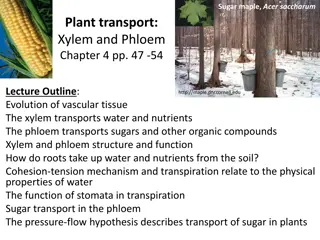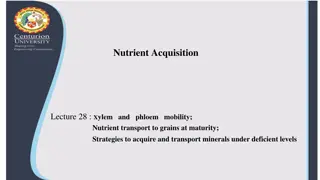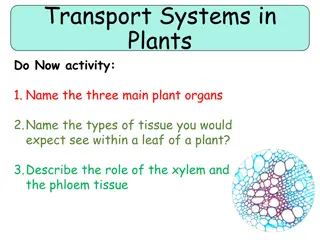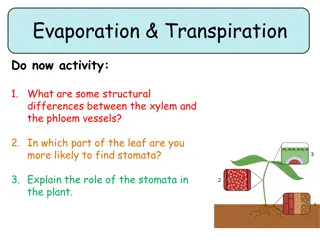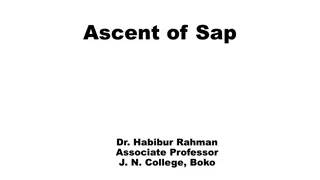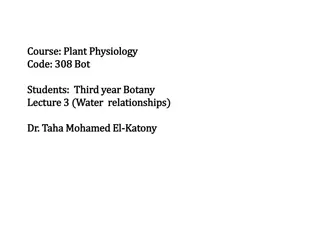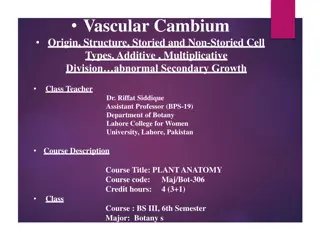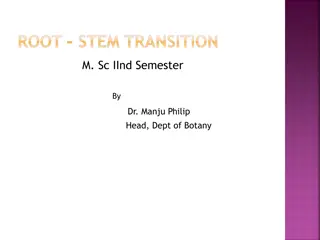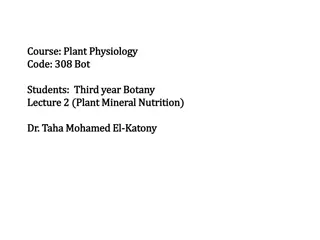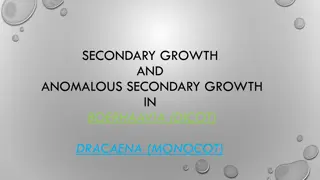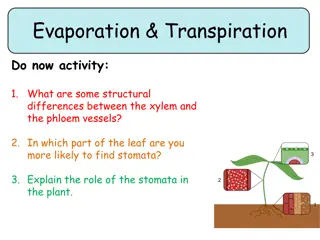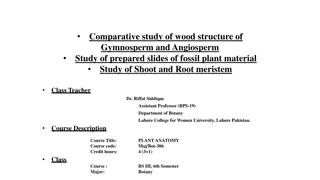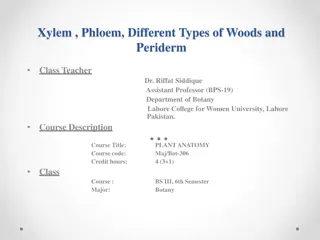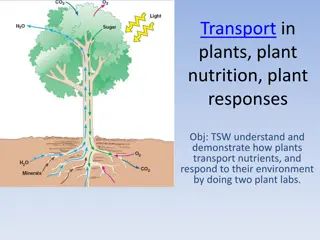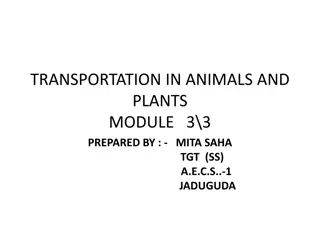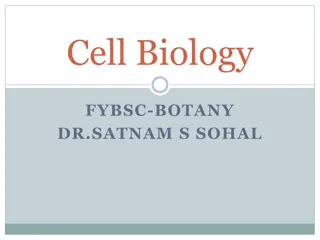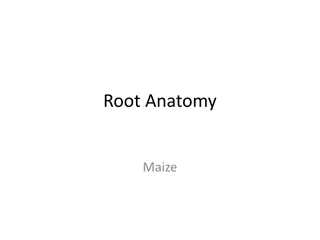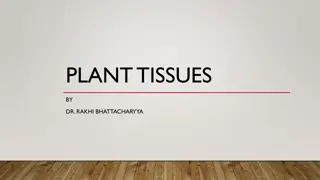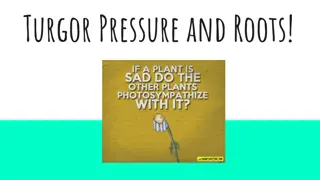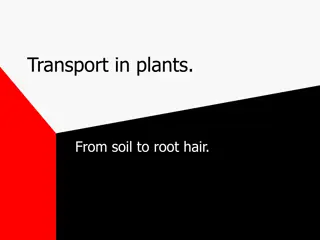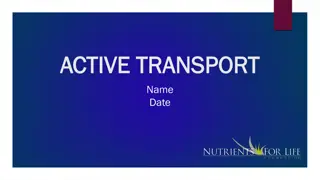Understanding Plant Transport Systems: Xylem and Phloem
Explore the intricate system of plant transport through xylem and phloem, from how roots absorb water to the pressure-flow hypothesis in sugar transport. Learn about the evolution, structure, and function of vascular tissues and the critical role of transpiration. Dive into the classification of pla
3 views • 27 slides
Nutrient Acquisition
Plants utilize xylem and phloem to transport water, nutrients, and minerals throughout their structures. Xylem moves water and mineral salts from roots to leaves, while phloem transports sugars and amino acids from leaves to the rest of the plant. Nutrient acquisition involves passive and active tra
2 views • 6 slides
Understanding Plant Transport Systems: Xylem, Phloem, and Transpiration
This comprehensive lecture outline delves into the intricate mechanisms of water and nutrient transport in plants. Topics covered include the roles of xylem and phloem, root water uptake processes, cohesion-tension mechanism, transpiration, stomatal function, sugar transport in phloem, and the press
4 views • 23 slides
Understanding Fibres: Types, Classification, and Identification
Fibres are vital materials used in various industries. They are classified into natural, artificial, and synthetic categories based on their source. Differentiation of fibres occurs in pericyclic, phloem, and xylem regions. Identification involves microscopical examination, physical tests, and chemi
2 views • 30 slides
Understanding Plant Transport Systems: Organs, Tissues, and Functions
Explore the key components of plant transport systems including organs, tissues, and the roles of xylem and phloem in transporting water, sugars, and minerals essential for plant life. Engage in activities, assessments, and a video to deepen your understanding.
0 views • 14 slides
Understanding Plant Evaporation and Transpiration Processes
Learn about the structural differences between xylem and phloem vessels, the role of stomata in plant leaves, and how water loss occurs through transpiration. Discover how guard cells regulate stomata openings and watch a video explaining transpiration processes in plants. Test your knowledge with s
0 views • 11 slides
Mechanisms of Sap Ascent in Plants Explained
Sap ascent in plants, primarily through xylem, is crucial for transporting water and nutrients. Theories such as vital force, root pressure, and cohesion tension attempt to explain this process, highlighting mechanisms like osmotic concentration and electro-osmotic potential. Root pressure theory pr
0 views • 20 slides
Understanding Root Pressure in Plant Physiology
Root pressure is the pressure developing in xylem vessels due to metabolic activities of the roots. It is an active process driven by osmotic mechanisms and the absorption of salts by the roots. This pressure plays a key role in translocation of water, affecting factors like respiration, exudation r
1 views • 20 slides
Understanding Vascular Cambium in Plant Anatomy
Vascular cambium is a crucial growth layer in stems and roots, responsible for producing xylem and phloem in plants. It originates from the maturation of procambium cells, differentiating into storied and non-storied cell types. It plays a vital role in secondary growth by generating new wood in woo
0 views • 26 slides
Understanding Vascular Transition in Root-Stem Structure
Root and stem in plants form a continuous structure with a transition region between them. The transition involves twisting and inversion of xylem strands, leading to variations in vascular bundles. Eames and Mac Daniels identified different types of vascular transitions in dicots and monocots, each
1 views • 13 slides
Plant Mineral Nutrition: Absorption and Circulation of Ions in Roots
Plant mineral nutrition involves the absorption and translocation of ions across roots. Salts are absorbed passively and actively, with ions moving into the root's apoplasm via free diffusion. The Casparian strip in endodermal cells acts as a barrier, allowing ions to pass only through the protoplas
0 views • 27 slides
Understanding Secondary Growth in Plants: Boerhaavia (Dicot) vs. Dracaena (Monocot)
Secondary growth, resulting from cambial cell division, thickens stems and roots in plants. This process involves cambium, a tissue layer between xylem and phloem, responsible for secondary growth. Cambium ray initials give rise to vascular rays and secondary xylem/phloem. The seasonal activity of c
0 views • 24 slides
Understanding Transpiration Process in Plants
Explore the intricate process of transpiration in plants, focusing on the roles of stomata, guard cells, and water movement. Learn about the structural differences between xylem and phloem vessels, stomata's function in regulating gas exchange, and how environmental factors impact transpiration rate
0 views • 14 slides
Comparative Study of Wood Structure in Gymnosperms and Angiosperms
This course in Plant Anatomy at Lahore College for Women University delves into the detailed examination of wood structures in Gymnosperms and Angiosperms. It involves analyzing prepared slides of fossil plant material, studying shoot and root meristems, and understanding the differences between har
0 views • 9 slides
Understanding Xylem, Phloem, and Vascular Bundles in Plant Anatomy
Exploring the intricate structures of xylem and phloem, essential components of plant vascular bundles. Discover the functions and components of xylem, including tracheides and vessels, as well as the patterns of secondary thickening. Learn about the roles of phloem in transporting nutrients through
0 views • 33 slides
Understanding Plant Transport, Nutrition, and Responses
The process of how plants transport nutrients and respond to their environment is demonstrated through labs focusing on protein transport, water absorption by roots, and control of transpiration using mechanisms like diffusion, osmosis, and symbiotic relationships with fungi. Various components in p
0 views • 28 slides
Understanding Transportation in Animals and Plants Module
This module explores the transportation processes in plants, focusing on how water and nutrients are absorbed through roots, the role of root hairs, vascular tissue, xylem and phloem in transporting substances, and the important process of transpiration in cooling and water release. It highlights th
0 views • 8 slides
Understanding Plant Cell Walls: Structure and Function
Plant cell walls play a crucial role in providing structure and protection to plant cells. This article delves into the composition of primary and secondary cell walls, highlighting the presence of cellulose, pectins, and glycans. The secondary cell wall, rich in lignin, offers mechanical support, e
0 views • 38 slides
Maize Root Anatomy: An In-depth Examination
Maize root anatomy involves various specialized structures such as the epidermis, cortex, endodermis, pericycle, and vascular tissue. The epidermis is crucial for absorption and protection, while the cortex plays a role in providing support and storage. The endodermis acts as a barrier and regulates
0 views • 9 slides
Understanding Plant Tissues and Meristems in Botany
Plant tissues are groups of cells with similar structures and functions. They can be classified into meristematic, permanent, and secretory tissues. Meristems are regions of continuous cell division found in plant tips and cambium, essential for growth. Primary meristems are present from the embryo
0 views • 28 slides
Plant Classification and Reproduction Overview
Plants are categorized into four groups: Mosses, Ferns, Conifers, and Flowering Plants. Mosses reproduce by spores and lack roots or xylem vessels. Ferns reproduce via spores, while conifers reproduce with seeds found in cones and have needle-shaped leaves. Flowering plants reproduce using seeds fou
0 views • 8 slides
Fascinating Insights into Plant Physiology and Water Transport Mechanisms
Delve into the intricate world of plant biology with discussions on osmosis, diffusion, active transport, root pressure, transpiration, cohesion, adhesion, and turgor pressure. Explore how water and nutrients are absorbed by roots, transported through xylem to the leaves, and how sugars are produced
0 views • 14 slides
Understanding Water Transport in Plants: From Soil to Xylem
Explore the fascinating journey of water in plants, starting from absorption by root hairs in the soil to its transportation through the root structure, including the cortex pathways, and into the xylem tissue for support and further distribution. Discover the essential role of xylem vessels and tra
0 views • 11 slides
Understanding Plant and Soil Interactions Through Active Transport
Explore how plants move water and nutrients using diffusion and active transport. Conduct a hands-on activity with celery to observe the process in action. Gain insights into the role of xylem in plant physiology.
0 views • 8 slides
Understanding the Anatomy and Functions of Plant Stems
Plant stems play a crucial role in the growth and survival of plants. They transport water, minerals, and sugars, support leaves and flowers, and store food. The outer structures of stems, such as buds and nodes, are essential for plant growth. Furthermore, the tissues inside the stem, including xyl
0 views • 12 slides
